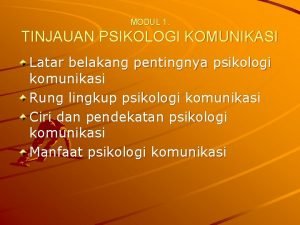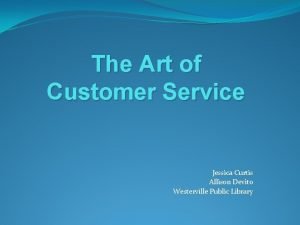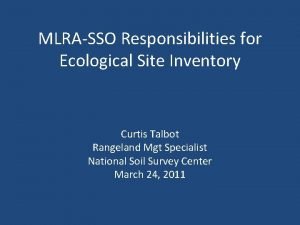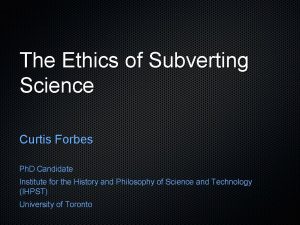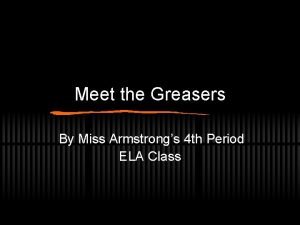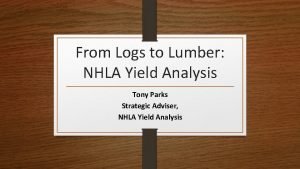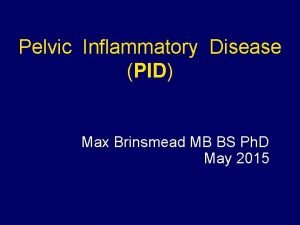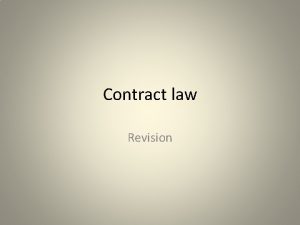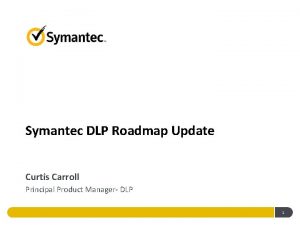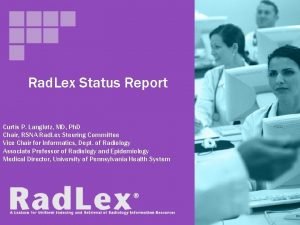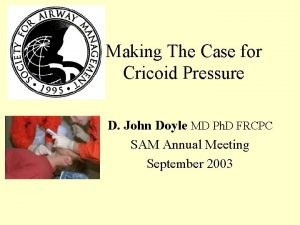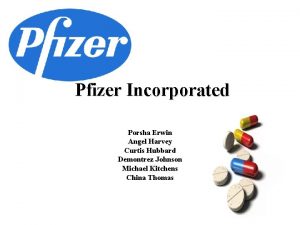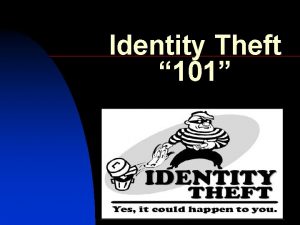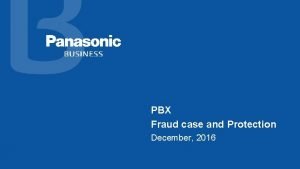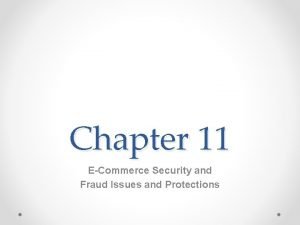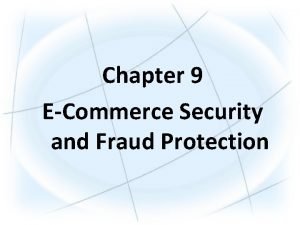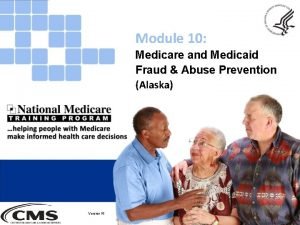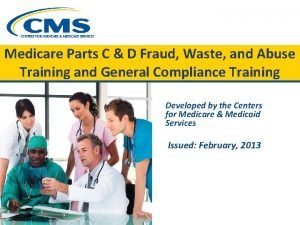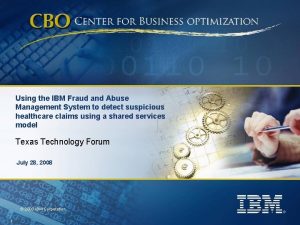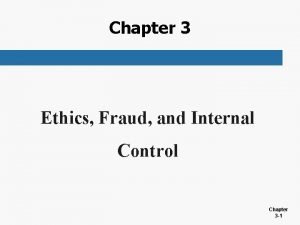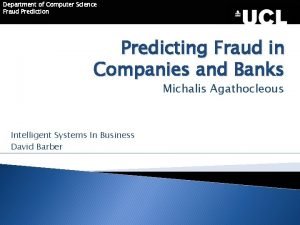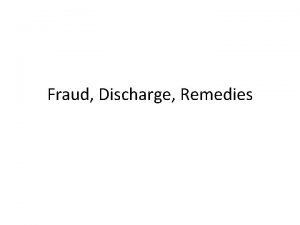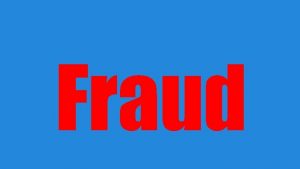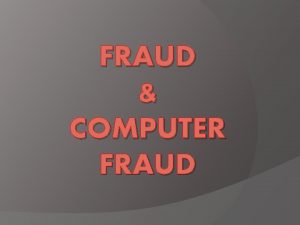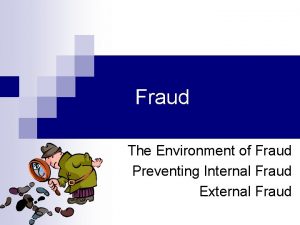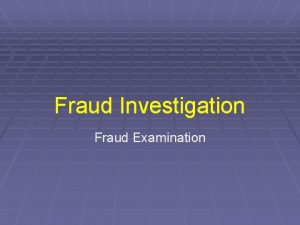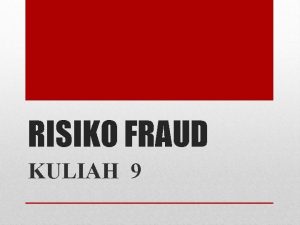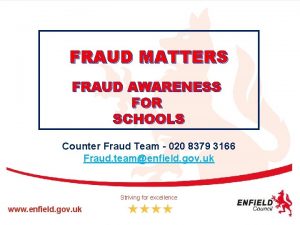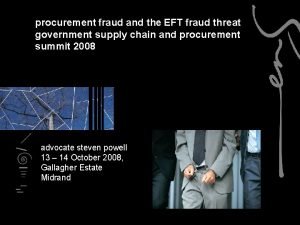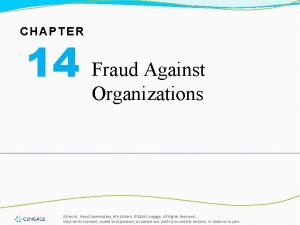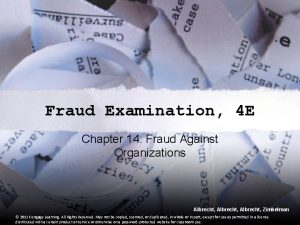Understanding Government Related Fraud August 8 2014 Curtis




































































- Slides: 68

Understanding Government Related Fraud August 8, 2014 Curtis A Binney, CPA CFE

What is Fraud ? … all multifarious means which human ingenuity can devise, and which are sorted to by one individual to get an advantage over another by false suggestions or suppression of the truth. Blacks Law Dictionary

Government Fraud – intentional acts designed to deprive the government of funds by deception or other unfair means. In 2008, losses from fraud, misuse, and other types of improper government payments are about $100 billion a year.

SAS 99 Establishes standards and provides guidance to auditors in fulfilling their responsibility, as it relates to fraud, in an audit of financial statements, conducted in accordance with GAAS

The Auditor’s Responsibility • “the auditor has a responsibility to plan and perform the audit to obtain reasonable assurance about whether the financial statements are free of material misstatement, whether caused by error or fraud. ” • “even a properly planned and performed audit may not detect a material misstatement resulting from fraud. ” • Provide reasonable assurance not absolute assurance

Inherent Conflicts in Auditing Auditor is often paid directly by the audit client. Desire to keep a happy client versus the need to persistent Human nature to trust versus need for professional skepticism Natural assumption that misstatements are due to errors instead of fraud Pressures for profitability, productivity, timeliness versus the need for more evidence and documentation

Auditor’s Perspective Errors are easier to identify (no intent to conceal) Fraud is harder to identify (intent to conceal) Therefore, auditing for misstatements caused by fraud dictates the need for a different audit response than the risk of misstatements caused by errors

Characteristics of SAS 99 Fraud �Intentional acts that result in a material misstatement of the financial statements �Auditors do not make a legal determination of whether a fraud has occurred �Intent is often very difficult to determine �Auditors make a determination as to whether evidence indicates a fraud may exist

Government Characteristics Affecting Motive/Pressures Profit motive generally less applicable Political promises and favors may impact decisions and actions Limited competitive environment Budgetary and other legal compliance pressures Limited use of external financial statements Limited financial related incentives for management Generally less pay than comparable private sector position

The Fraud Triangle Motive Opportunity Rationalization

Fraud Risk Factors Motive/Incentive/Pressure (the reason to commit fraud) Opportunity (the ability to commit fraud) Rationalization (the justification to commit fraud)

Types of SAS 99 Fraud Misstatements arising from fraudulent financial reporting Intentional misrepresentation in or omission of material events, transactions or other information Intentional misapplication of GAAP Falsification or manipulation of accounting records or documents Misstatements arising from misappropriation of assets Theft that causes the financial statements to not be fairly presented in all material respects

Audit Fraud Process Brainstorming Obtaining Risk Info Documenting Communicating On-Going Process Throughout The Audit Evaluating Evidence Identifying Risks Assessing Risks Responding to Risks

Brainstorming Initially during audit planning Interactive exchange of ideas Insights of more experienced team members How and where the financial statements might be susceptible to fraud • Emphasize importance of proper state of mind (professional skepticism) during the audit • Include risk of management override of controls • Communication of fraud risks among team members should continue throughout the audit • •

Obtaining Risk Information • Inquiries of management and others about fraud risk and their response to the risk • Consider unusual relationships that analytical procedures identify • Consider the presence of fraud risk factors • Consider results of procedures over acceptance and continuance of clients • Consider any reviews of interim financials • Consider inherent risks at account balance/ transaction class level

Obtaining Risk Information (Cont) • Evaluate the relationship between management and the audit committee or equivalent (New) • Talk to the internal auditors (New) • Inquire directly of the audit committee or equivalent (New) • Entity employees may just waiting to be asked • Be alert for inconsistent responses to inquiries and use professional judgment in deciding when corroboration is needed

Identifying Fraud Risks • Professional judgment required • Risk attributes to consider: (New) – Type of risk – Significance of the risk – Likelihood of the risk – Pervasiveness of the risk • Consider these in the context of the fraud triangle; but do not assume that if all three are not evident, there is no risk

Identifying Fraud Risks (con’t) • Consider the entity’s size, complexity, and ownership/governing attributes • Consider assertions, accounts, and transaction classes that have high inherent risk due to a high degree of management judgment and subjectivity • Consider whether identified risks pertain to (A) individual account balances, transaction classes, or assertions or (B) the financial statements as a whole • Should ordinarily presume there is a risk of material misstatement due to revenue recognition fraud • Always consider management’s ability to override controls apart from specifically identified risks

Assessing Fraud Risks • Assessment should take into account an evaluation of the entity’s programs and controls that address fraud risks • There may be specific programs/controls that address specific fraud risks – Are they properly designed and been implemented? • There may be broader programs designed to prevent, deter, or detect fraud risk • For example: programs that promote a culture of honesty and ethical behavior

Responding to Fraud Risks There are three ways to respond: General considerations related to the overall way the audit is conducted Change the nature, timing, or extent of audit procedures Performance of procedures to address the risks related to management’s ability to override controls

General Considerations • Heightened professional skepticism and assessment of audit evidence – Design different procedures – Corroborate management explanations • Assignment of personnel and supervision – Additional or more experienced staff – Use of specialists – Greater supervision • Reassess accounting principles application • Add unpredictability to audit procedures

Nature, Timing and Extent of Audit Procedures • Use more reliable or corroborative procedures • More inspection or observation • Expanded inquiries or independent confirmation • Alter the timing of substantive tests • Conduct more testing – Larger sample sizes – Analytical procedures at a more detailed level – Use CAATs to test all transactions of a population

Responses to Management Override • Examine journal entries and other adjustments for evidence of material misstatement • Review accounting estimates for evidence of biases that could result in material misstatements due to fraud • Evaluate the business rationale for significant unusual transactions

Responses to Management Override • Appropriate for every audit absent a conclusion by the auditor that they are unnecessary—document such a conclusion • For audits of public entities, these “should” be performed • For audits of nonpublic entities, these “should generally” be performed • Bottom line: if you decide not to perform these procedures, you better have good, well-documented reasons

Evaluating Audit Evidence for Fraud • Assess and reassess risks of material misstatement due to fraud throughout the audit • Audit test results may alter previous assessments of risk • Audit test results may, in and of themselves, be indicative of fraud • Be alert for: (New) – Discrepancies in the accounting records – Conflicting or missing evidential matter – Problematic or unusual relationships between the auditor and client

Responding to Misstatements That May Be Result of Fraud • Consider the implications for other parts of the audit • Discuss the matter and the approach for further investigation with an appropriate level of management; and with senior management: and the audit committee • Attempt to obtain additional evidential matter to determine whether material fraud has occurred • Consider the need for and timing of discussions with the audit committee or board of directors (New) • If appropriate, suggest that the client consult with legal counsel • When appropriate, consider withdrawing from the engagement (consult with auditor’s legal counsel)

Communicating Fraud Evidence • Whenever “evidence of fraud” is found, it should be brought to the attention of the appropriate level of management – Even if the matter is inconsequential • Report directly to the audit committee when: – Fraud causes a material misstatement – Fraud involves senior management • Reach an advance understanding with the audit committee about fraud involving lower-level employees

Communicating Fraud Evidence • Communicating to parties other than management or audit committee may be required – To comply with legal or regulatory requirements – In response to successor auditor inquiries (per SAS 84) – In response to a subpoena – To meet Yellow Book standards • “Consult your attorney”

Types of Government Fraud Public Corruption False Claims and Statements Procurement Fraud Social Security Fraud Welfare Fraud Medicare and Medicaid Fraud Tax Fraud Counterfeit Currency Conspiracy to Defraud the Government Grant Fraud Asset Misappropriations

Public Corruption – the wrongful use of influence in a business dealing to procure a benefit for the actor or another person, contrary to their duty to their employer. Bribery Kickbacks Illegal gratuities Economic extortion Collusion Conflicts of Interest

Corruption Schemes Bribery and Kickbacks Bribery – the offering, giving, receiving, or soliciting of anything of value to influence an official act. Kickbacks – undisclosed payments by vendors to employees of purchasing organizations, to influence an official act. Both nearly always include collusion

Corruption Schemes (con’t) Illegal Gratuities – something of value given to another party to reward a party that has already been made. Economic Extortion – employee or official through the wrongful use of actual or threatened force or fear, demands money or some other consideration to make a particular decision.

ACFE Corruption Warning Signs Regularly accepts inappropriate gifts Very friendly social relationships Extravagant lifestyle Override of existing rules and SOPs Official makes excuses for deficiencies in payers performance Extreme personal pressures Suspected fraudster involved with organization Decrease in quality and/or increase in price

False Claims and Statements False Statement – a statement that was known to be untrue when it was made. Section 1001, Title 18 USC. Elements of a false statement: Defendant made a false statement Statement was material Statement was within the jurisdiction of a federal agency. Defendant knew the claim was false The Agency did not have to rely on the statement

Types of False Statements Contracting bids or proposals False certifications or assurances contract Billing documents Records or invoices Progress reports Test or inspection results Duplicate or altered invoices Inflated costs or substitution of cheaper goods Fictitious transactions

Procurement Fraud Public Procurement refers to those processes, procedures, and entities involved in the government’s process of acquiring goods and services. Collusion among contractors Collusion between contractors and employees Performance Schemes

Methods of Procurement Simplified acquisition Sealed Bids Competetive negotiation Noncompetetive proposals (sole source)

Phases in Procurement Pre-solicitation Phase Solicitation Phase Bid-evaluation Phase Post Award Phase – Administration Phase

Collusion Among Contractors Collusion is a type of fraud where two or more individuals agree to commit an act designed to deceive or gain an unfair advantage. Common Types Complementary bidding (token bids) Bid rotation Bid suppression Market division

Complementary Bidding Complementary bidding (also known as protective, shadow, or cover bidding) occurs when competitors submit token bids that are not serious attempts to win. For the conspirators to bid higher than the designated winning bidder, they might agree to submit: • Bids that are too high to be accepted • Bids that appear to be competitive in price but deliberately fail to meet other requirements of the tender • Bids that contain special terms that will not be acceptable to the buyer

Bid Rotation Bid rotation schemes occur when two or more contractors conspire to alternate the business between them on a rotating basis. Instead of engaging in competitive contracting, which drives down the contract price, contractors perpetrating these schemes prefer exchanging information on contract solicitations to guarantee that each contractor will win a share of the purchasing entity’s business. Similar to complementary bidding schemes, bid rotation schemes may be coupled with a scheme to award subcontracts to losing bidders. This allows losing bidders to improve their cash flow as they wait for their turn to win. Similarly, losing bidders might receive a percentage of the winning company’s profits.

Bid Suppression Bid suppression occurs when two or more contractors enter an illegal agreement whereby at least one of the conspirators refrains from bidding or withdraws a previously submitted bid. The goal of these schemes is to ensure that a particular competitor’s bid will be accepted.

Market Division Market division schemes involve agreements in which competitors divide markets among themselves and refrain from competing in each other’s designated portion of the market. Markets are generally divided according to geographic area—the competitors take turns on contracts according to the geographic area— or are based on the customer—the competitors allocate specific customers or types of customers among themselves.

Market Division The result of these schemes is that competing firms will not bid against each other, or they will submit only complementary bids when a solicitation for bids is made by a customer or in an area not assigned to them. The customer thereby loses the benefit of true competition and ends up paying a higher price than would be dictated by fair bidding under normal economic forces. Corrupt contractors often conceal market division schemes by submitting bids from shell companies (i. e. , companies that have no physical presence and generate little independent economic value).

Collusion Between Contractors and Employees Types of Schemes Need recognition Bid tailoring Bid manipulation Unbalanced bidding Leaking bid data Bid splitting Unjustified sole source awards

Needs Recognition Generally, procurement actions begin with the procuring entity making a determination of its general needs. These initial determinations include assessments of the types and amounts of goods or services required to meet the entity’s needs. Fraud occurring during this phase of the procurement process may result in decisions to purchase excessive or possibly unnecessary goods or services.

Needs Recognition Typically, need recognition schemes involve the following scenarios: • Purchases for personal use or resale—In these schemes, employees with procurement authority exploit their position of power by using their employer’s funds to obtain items for their personal use or resale (e. g. , tools, office supplies, computers, automobile parts, etc. ). • Unnecessary purchases—In these schemes, an employee of the buyer receives something of value and in return recognizes a need for a particular product or service offered by the supplier. • Excessive purchases—In these schemes, a corrupt employee purchases goods or services in excess of amounts actually needed.

Bid Tailoring Bid-tailoring schemes occur during the pre-solicitation phase. In these schemes, an employee with procurement responsibilities, often in collusion with a supplier or contractor, manipulates bid specifications to give an unfair advantage to a certain contractor. Bid specifications are a list of elements, measurements, materials, characteristics, required functions, product name or brand number, and other specific information relevant for completion of the project. Specifications are included to assist contractors in the bidding process, informing them what they are required to do and providing information necessary to make and accept bids.

Bid Manipulation In these schemes, which occur during the solicitation phase, a procuring employee manipulates the bidding process to benefit a favored contractor or supplier. Some common ways to commit these schemes include: • Accepting late bids • Altering bids • Extending bid opening dates Prematurely opening bids • Unnecessarily re-bidding work • Discarding or losing a bid or proposal • Improper disqualification

Unbalanced Bidding Unbalanced bidding is a type of bid submission scheme in which a bidder, usually in collusion with contracting personnel, becomes aware that one of several line items in a request for a bid on certain works, goods, or services will not be called for under the contract. This information, which is not available to other bidders, allows the favored firm to submit a very low price for the line item and to be the overall low bidder.

Leaking Bid Data Employees of a procuring entity can leak pre-bid information or confidential information from competing bidders to a favored bidder, giving that bidder an unfair advantage in the bidding process. Typically, these schemes occur as the result of corruption.

Bid Splitting In bid-splitting schemes, employees of a procuring entity split large contracts into smaller contracts, allowing them to avoid the scrutiny required for larger dollar value contracts. In basic terms, splitting bids into several separate tenders creates more opportunities for corrupt employees to influence the award. Bid splitting often is used to avoid competitive bidding. Because procuring entities are generally required to use competitive methods for projects over a certain dollar amount, employees of a procuring entity might break a large project up into several small projects to avoid these requirements.

Unjustified Sole Source Awards Sole source contracting is an exception to the general rule of competition; it is a noncompetitive procurement process accomplished through the solicitation of only one source, thereby limiting full and open competition. Because quotation and bid requirements do not apply to sole source purchases, procurement through this process requires justification, which typically occurs when the goods or services are available only from a single source, when exigent circumstances will not permit delay resulting from a competitive solicitation, or when solicitation is determined inadequate after soliciting a number of sources. Therefore, unjustified sole source contracts unfairly exclude competition. Sole source contracting is more vulnerable to fraud because there is greater freedom for manipulation and collusion with a vendor/contractor, and because of this, federal government entities cannot conduct sole source acquisitions unless they provide their justifications in writing and the acquisition is approved at all necessary levels.

Performance Schemes Occurs during the performance phase of a contract. Types of performance schemes: Progress payment fraud False or inflated invoices Duplicate Invoices Non-conforming goods or services Change order abuse Cost mischarging Commingling of contracts

Progress Payment Fraud Progress payment fraud is a specific type of fraud that occurs in government contracts. Progress payments are payments made as work progresses under a contract. Generally, progress payments are based upon the costs incurred, the percentage of work completed, or the completion of a particular milestone. Fraud in progress payments occurs when a contractor submits a progress payment request based on false statements, such as false direct labor charges, material costs for items not actually purchased, or false certification of work completed.

False, Inflated, and Duplicate Invoices To generate false payments, a contractor or vendor may submit false, inflated, or duplicate invoices—itemized statements of money owed for goods or services supplied. When perpetrating these schemes, the contractor may be acting alone or in collusion with an employee of the victim organization who shares in the profits. False invoices are invoices submitted when no goods or services were provided, or they are invoices that do not properly represent the quantity or quality of goods and services supplied or work done as per contracted specifications Inflated invoices include bills that charge for a higher grade, cost of material, or service than actually delivered. Duplicate invoices occur when a contractor separately submits copies of the same invoice for payments, or submits more than one original invoice for the same goods or services, and is subsequently paid twice.

Non-Conforming Goods or Services Non-conforming goods or services fraud refers to attempts by contractors to deliver goods or services to the procuring entity that do not conform to the contract specifications. The contractor then bills and receives payment for conforming goods or services without informing the purchaser of the deficiency. This type of scheme can be committed by the contractor acting alone, or it can be facilitated by procurement or inspection personnel as the result of corruption. In non-conforming fraud schemes involving corruption, the dishonest supplier might give gifts or favors to inspectors or pay kickbacks to contracting officials to facilitate the scheme. The supplier would then submit false documentation to conceal it. Delivery of inferior/substandard material • Delivery of materials that have not been tested • Falsification of test results • Delivery of used, surplus, or reworked parts • Delivery of counterfeit products • Submission of false certifications • Product substitution

Change Order Abuse In change order abuse schemes, a bidding contractor submits a low bid to ensure the winning of the contract award, but a corrupt employee of the procuring entity has assured the contractor that contracting personnel will prepare contract change orders during the life of the contract, which will more than compensate for the low bid. After the procuring entity awards the contract, the corrupt contractor increases its price by submitting change order requests. If successful, these schemes will, at the very least, cause the procuring entity to lose any advantage received through the competitive bidding process. Similarly, a dishonest contractor, acting in collusion with contract personnel, can use the change order process to improperly extend or expand contracts and avoid re-bidding. Change orders generally receive less scrutiny than the bidding process or the negotiation of contract terms, making them a popular way to fraudulently access funds or generate funds for kickbacks.

Cost Mischarging Cost mischarging schemes occur when a contractor charges the procuring entity for costs that are not allowable, not reasonable, or that cannot be allocated to the contract directly or indirectly. There are three types of mischarges perpetrated by contractors: • Accounting mischarges—These occur when a contractor knowingly charges or conceals unallowable costs within allowable expenses or in accounts that are not closely monitored (e. g. , office supplies). Another common variation involves charging types of costs with limits, such as bid and proposal costs or independent research and development costs, to other cost categories.

Cost Mischarging Material mischarges—Occasionally, material costs are mischarged, both as to their reasonableness and their allocation. • Labor mischarges—Labor mischarging occurs when the contractor charges the procuring entity for work that was not actually performed. Labor costs are perhaps more susceptible to mischarging than material costs because, unlike other items of cost, labor is not supported by external documentation or physical evidence to provide an independent check or balance, and because employee labor can readily be charged to any contract.

Commingling of Contracts In situations where contractors are awarded more than one contract, they may collude with an employee of the procuring entity who will write similar work orders to facilitate the duplicate billing. As a result, each contract has provisions to allow for items that are in the other contracts. Commingling schemes often involve duplicate contract payments. In these schemes, the contractor submits copies of the same invoices for payment, or submits more than one copy of the same invoice for the same goods and services, and is subsequently paid twice.

Conspiracy Criminal conspiracy - an agreement between two or more people to commit an illegal act. Separate criminal act Conspiracy to defraud the United States – any conspiracy for the purpose of impairing, obstructing, or defeating the lawful function of any department of government.

Grant Fraud – the intentional misuse of grant funds in a manner that is not consistent with the goals and objectives identified in the grant. Major Categories: Conflicts of interest False grant claims Theft

Asset Misappropriation Schemes Cash Schemes Fraudulent disbursements Cash larceny Skimming Non-Cash Schemes Theft or misuse of inventory, equipment, supplies or other physical assets of the company

Fraud Prevention and Deterrence Internal Controls Control Environment Fraud risk assessment Control activities Information and communication Monitoring Tone at the Top Fraud Prevention Programs

Fraud Prevention Programs – methods by which management can institute policies and procedures to help detect and prevent fraud, including; Past employment verification Criminal conviction checks Credit Check Reference checks Education and certification verification Employee education Reporting activities

Fraud Prevention Programs (con’t) Hotlines Proactive audit policies Enforcement of mandatory vacations Job rotation Fraud policy Ethics programs

Questions And Discussion? Special Thanks To: The Association of Certified Fraud Examiners www. ACFE. com For More Information: Curt Binney curt@sbmcpa. us
 How do fraud symptoms help in detecting fraud
How do fraud symptoms help in detecting fraud Two types of physical fitness
Two types of physical fitness Fitness related images
Fitness related images National government vs federal government
National government vs federal government Makalah ruang lingkup psikologi komunikasi
Makalah ruang lingkup psikologi komunikasi Curtis pate
Curtis pate Art of customer service
Art of customer service Ponyboy characteristics
Ponyboy characteristics Curtis lumber granville ny
Curtis lumber granville ny Curtis carolingia
Curtis carolingia Karen curtis ilo
Karen curtis ilo Heber curtis
Heber curtis Gifted hands chapter 1 summary
Gifted hands chapter 1 summary Rueda curtis
Rueda curtis Strato di valenza
Strato di valenza Curtis barry md
Curtis barry md La curtis mappa concettuale
La curtis mappa concettuale Curtis talbot
Curtis talbot Sheldon russell curtis
Sheldon russell curtis Curtis bennett national aquarium
Curtis bennett national aquarium Symbols that represent sodapop curtis
Symbols that represent sodapop curtis Curtis forbes
Curtis forbes Greasers personality traits
Greasers personality traits Christopher paul curtis facts
Christopher paul curtis facts Curtis cole utsc
Curtis cole utsc Curtis lumber co. inc.
Curtis lumber co. inc. Fitzu curtis syndrome
Fitzu curtis syndrome Planche v colburn 1831
Planche v colburn 1831 Cherry valance description
Cherry valance description Steve randle challenges
Steve randle challenges Heber curtis
Heber curtis Curtis hays whitson
Curtis hays whitson Curtis parry
Curtis parry Thestudygenie
Thestudygenie Steve curtis cancer
Steve curtis cancer Curtis stage steam turbine
Curtis stage steam turbine Dominicum e massaricium
Dominicum e massaricium Curtis mendelson
Curtis mendelson Curtis barry md
Curtis barry md Normal female chromosome
Normal female chromosome Radiology terminology
Radiology terminology Beato curtis
Beato curtis Curve di riscaldamento e raffreddamento zanichelli
Curve di riscaldamento e raffreddamento zanichelli Watsons of dayton
Watsons of dayton What is sodapop's best accomplishments
What is sodapop's best accomplishments Rolland curtis gardens
Rolland curtis gardens Erin curtis
Erin curtis Curtis kendall
Curtis kendall Dlp roadmap
Dlp roadmap Curtis medievale
Curtis medievale Curt langlotz
Curt langlotz How was the shapley-curtis debate resolved?
How was the shapley-curtis debate resolved? Curtis wohlfeld
Curtis wohlfeld Curtis lester mendelson
Curtis lester mendelson Curtis hubbard
Curtis hubbard Curtis ebbesmeyer
Curtis ebbesmeyer Identity theft 101
Identity theft 101 Pbx fraud
Pbx fraud Yazoo land fraud cartoon
Yazoo land fraud cartoon Ecommerce security issues
Ecommerce security issues E commerce security and fraud protection
E commerce security and fraud protection Fraud and abuse module
Fraud and abuse module Fraud waste and abuse training answers
Fraud waste and abuse training answers Ibm fams
Ibm fams Database management fraud includes altering
Database management fraud includes altering Predicting fraud
Predicting fraud Why did the yazoo land fraud occur?
Why did the yazoo land fraud occur? Chapter 7 fraud internal control and cash
Chapter 7 fraud internal control and cash Computer fraud and abuse techniques
Computer fraud and abuse techniques




